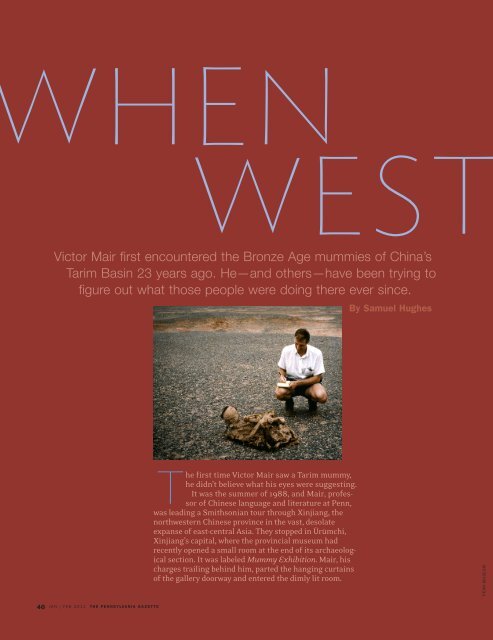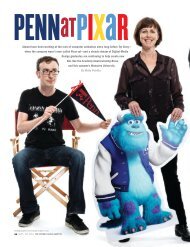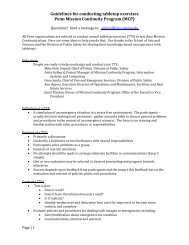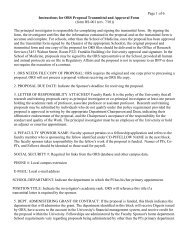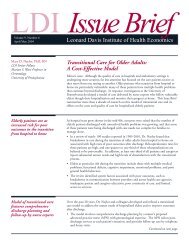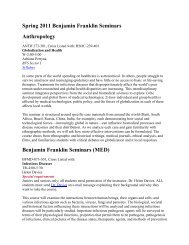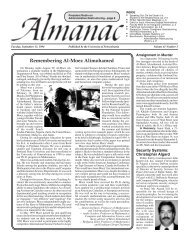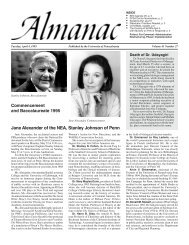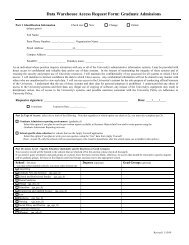Download this article (PDF) - University of Pennsylvania
Download this article (PDF) - University of Pennsylvania
Download this article (PDF) - University of Pennsylvania
Create successful ePaper yourself
Turn your PDF publications into a flip-book with our unique Google optimized e-Paper software.
HEN<br />
WEST W<br />
Victor Mair first encountered the Bronze Age mummies <strong>of</strong> China’s<br />
Tarim Basin 23 years ago. He—and others—have been trying to<br />
figure out what those people were doing there ever since.<br />
By Samuel Hughes<br />
The first time Victor Mair saw a Tarim mummy,<br />
he didn’t believe what his eyes were suggesting.<br />
It was the summer <strong>of</strong> 1988, and Mair, pr<strong>of</strong>essor<br />
<strong>of</strong> Chinese language and literature at Penn,<br />
was leading a Smithsonian tour through Xinjiang, the<br />
northwestern Chinese province in the vast, desolate<br />
expanse <strong>of</strong> east-central Asia. They stopped in Ürümchi,<br />
Xinjiang’s capital, where the provincial museum had<br />
recently opened a small room at the end <strong>of</strong> its archaeological<br />
section. It was labeled Mummy Exhibition. Mair, his<br />
charges trailing behind him, parted the hanging curtains<br />
<strong>of</strong> the gallery doorway and entered the dimly lit room.<br />
PENN MUSEUM<br />
40 JAN | FEB 2011 THE PENNSYLVANIA GAZETTE
ENT<br />
East<br />
THE PENNSYLVANIA GAZETTE JAN | FEB 2011 41
He found himself surrounded by mummies, maybe half a dozen At that point, though, he was still a “Chinese language and<br />
in all. Not the usual sort <strong>of</strong> mummies, wrapped in rotting gauze literature guy with a lot <strong>of</strong> experience about central Asia,”<br />
or looking like something out <strong>of</strong> a zombie movie. These were albeit one who was “curious about everything.” And the discovery<br />
<strong>of</strong> Ötzi “galvanized” him.<br />
astonishingly well-preserved people <strong>of</strong> decidedly un-Chinese<br />
appearance, dressed in their everyday clothes. Though their “What really goaded me to go to the mummies was that [Ötzi]<br />
remains were identified as thousands <strong>of</strong> years old, they looked as had an army <strong>of</strong> researchers working on him,” he adds. “It wasn’t<br />
though they were sleeping and could wake up at any moment. fair. Those Xinjiang mummies—nobody was working on them;<br />
Mair was stunned—and skeptical.<br />
nobody even knew about them. I said to myself, ‘They’re every<br />
“I looked at the mummies and said, ‘Oh, <strong>this</strong> is a hoax,’” he bit as important as he is. Maybe even more important.’ They’re<br />
says. “They looked like something out <strong>of</strong> Madame Tussauds in the center <strong>of</strong> Asia, at the crossroads <strong>of</strong> Asia. Before that it<br />
Wax Museum—they’re too well preserved. Then all the clothing<br />
was so immaculate, so pristine, and the colors were very den there were all these Caucasian people with all <strong>this</strong> advanced<br />
was just a big lacuna in that part <strong>of</strong> the world; then all <strong>of</strong> a sud-<br />
vivid and bright. And perfectly intact! Nothing destroyed.” technology, right up there against China—very early.”<br />
Mair had examined enough ancient manuscripts from the He pauses for just a moment, and adds: “That very afternoon,<br />
area to know that the salty sands and freeze-drying climate <strong>of</strong> I became an archaeologist.”<br />
the Tarim Basin, where the mummies were found, are highly<br />
conducive to preservation. (“The most linguistically diverse Richard Hodges, the Williams Director <strong>of</strong> the Penn<br />
library in the ancient world has survived in the drying sands<br />
Museum and an eminent archaeologist in his own<br />
<strong>of</strong> the Tarim Basin,” he and co-author James Mallory wrote in<br />
right, is talking with easy precision about the “two<br />
their 2000 book, The Tarim Mummies: Ancient China and the<br />
great issues” in world archaeology today.<br />
Mystery <strong>of</strong> the Earliest Peoples from the West.) But their One, he explains, is “that whole issue <strong>of</strong> man coming out <strong>of</strong><br />
remarkable condition wasn’t the only<br />
Africa, particularly sub-Sahara Africa,<br />
puzzling thing about these mummies.<br />
and crossing into the Middle East, then<br />
“They had all <strong>this</strong> advanced technology:<br />
bronze, and high-level textile tech-<br />
That’s a sort <strong>of</strong> prelude to the second<br />
moving eastwards and northwards.”<br />
nology, different kinds <strong>of</strong> tools—they<br />
issue—which, he says, involves “what<br />
had wheels, for example. Everything<br />
was happening between Asia and<br />
made me think <strong>this</strong> was too advanced<br />
Europe and the Middle East and <strong>this</strong><br />
for <strong>this</strong> time in <strong>this</strong> place.”<br />
crucible <strong>of</strong> the Old World” over the past<br />
Even more brain-scrambling was the<br />
three millennia.<br />
fact that they looked so … European. Their<br />
“The Tarim Basin is smack-bang in<br />
height (tall). Hair (blond, reddish-brown,<br />
the middle <strong>of</strong> <strong>this</strong> crucible,” Hodges<br />
fine-textured). Facial structure. Clothing.<br />
says forcefully. “And the archaeology<br />
Mair was especially drawn to one<br />
that’s come from it, the new finds that<br />
mummy whose remains were identified<br />
have been made in that region, are<br />
as dating back to 1000 BCE. Chärchän<br />
extraordinary.” The result is “a remarkable<br />
chance to get to grips with those<br />
Man, excavated from Chärchän (Qiemo The salty sands and freeze-drying climate <strong>of</strong><br />
in Modern Standard Mandarin), was sixfoot-seven,<br />
with longish blond-brown found, are highly conducive to preservation. ested archaeologists for centuries on a<br />
the Tarim Basin, where the mummies were extraordinary issues that have inter-<br />
hair and beard, and his clothing included<br />
a reddish-purple woolen shirt trimmed with red piping. because they were myopic,” Hodges adds. “And now <strong>this</strong> big,<br />
big scale”—until they “lost interest<br />
Mair promptly dubbed him Ur-David, on account <strong>of</strong> the grand narrative is back for us.”<br />
remarkable resemblance to his very-much-alive brother Dave. The narrative takes physical form in Secrets <strong>of</strong> the Silk<br />
But beyond that eerie resemblance bubbled a serious question:<br />
What in God’s name was a tall, fair-haired man with that that opens at the Penn Museum February 5 and runs through<br />
Road, an exhibition <strong>of</strong> Tarim Basin mummies and artifacts<br />
kind <strong>of</strong> clothing doing in east-central Asia 3,000 years ago? June 5. The exhibition is “fantastic,” says Hodges, “because<br />
Mair sent his tour members back to the hotel, and spent the it really demands that you have the kind <strong>of</strong> imagination to<br />
next few hours in that dark room, meditating on the implications<br />
<strong>of</strong> its inhabitants. He filed the mental images away and we are and where we came from.”<br />
look across huge distances and ask big questions about who<br />
went back to studying manuscripts.<br />
For Mair, the fact that an exhibition <strong>of</strong> Tarim mummies and<br />
Three years later, he found himself reading a story in The artifacts is coming to the Penn Museum at all borders on the<br />
New York Times about a frozen 5,300-year-old body that had “miraculous.” Not just because it’s a blockbuster show with dazzling<br />
objects and a raft <strong>of</strong> innovative special programs that rep-<br />
just been discovered in the Ötztaler Alps on the border between<br />
Austria and Italy. Ötzi the Iceman, as he became known, “died resents a quantum leap forward for the Museum, though it is and<br />
at the top <strong>of</strong> the Similaun Glacier, right near where my father it does. (See sidebar on p. 44.) It’s also that he had long since given<br />
pastured his animals when he was a boy,” says Mair. The weird up hope that any <strong>of</strong> those mummies and artifacts would ever<br />
convergence <strong>of</strong> time and place and pr<strong>of</strong>essional interests make it out <strong>of</strong> China, let alone to West Philadelphia.<br />
prompts a grin. “I was born to be a mummy guy,” he says.<br />
Fifteen years ago, he was turned down for a similar show, on<br />
42 JAN | FEB 2011 THE PENNSYLVANIA GAZETTE<br />
PENN MUSEUM
the not-unreasonable grounds that the Museum was illequipped<br />
to handle either the crowds or the climate-sensitive<br />
mummies. Efforts to get a venue at the Natural History<br />
Museum <strong>of</strong> Los Angeles County also foundered. So Mair went<br />
back to studying, excavating, writing about, and organizing<br />
conferences on the remarkable discoveries in Xinjiang.<br />
Then, in February 2009, he got a phone call from Peter<br />
Keller, head <strong>of</strong> the Bowers Museum in Santa Ana, California.<br />
The museum, Keller told him, was planning an exhibition <strong>of</strong><br />
Tarim mummies.<br />
“I said, ‘Oh, no, you can’t be,’” Mair recalls. “‘He said, ‘Oh yes<br />
we can. Do you want to be involved?’”<br />
Mair had to pick his jaw <strong>of</strong>f the floor before he could answer.<br />
“I said, ‘Man, <strong>this</strong> is like a dream! It’s not gonna happen!’<br />
He said, ‘Yes, it is.’”<br />
When Keller asked Mair if he wanted to edit the catalogue,<br />
the response was a high-octane affirmative. He then asked if<br />
Mair would be interested in having the exhibition come to<br />
the Penn Museum.<br />
“I said, ‘What?! That’s what we’ve<br />
been trying to do all these years!’”<br />
At that point Mair went to see Hodges,<br />
knowing he was facing long odds. But<br />
<strong>this</strong> time, the stars were in alignment.<br />
“We’re trying to work on two fronts<br />
that I think the <strong>University</strong> feels pleased<br />
about,” says Hodges. “First, we’re trying<br />
to work with faculty and students,<br />
and it’s great to have these sorts <strong>of</strong><br />
ideas come from a distinguished member<br />
<strong>of</strong> the faculty. Second, we’re trying<br />
to get a much larger audience for the<br />
Museum as a public museum, and we<br />
felt that <strong>this</strong> exhibition, albeit a little<br />
academic, actually meets the kind <strong>of</strong><br />
interest that the public have at the<br />
moment in archaeology.”<br />
Though his efforts to get an exhibition <strong>of</strong><br />
Tarim mummies at the Penn Museum in the mid-1990s fell<br />
short, Mair did organize a major international conference on<br />
the subject that he views as a “watershed,” one that “changed<br />
how people viewed the development <strong>of</strong> Eurasian civilization.”<br />
That 1996 conference yielded two volumes worth <strong>of</strong> papers,<br />
covering everything from linguistics and pottery styles to<br />
methods <strong>of</strong> tomb construction and ancient metallurgy.<br />
“That was, to the best <strong>of</strong> my knowledge, the only international<br />
conference that brought together so many people working on the<br />
major problems <strong>of</strong> east-central Asia,” says James Mallory, pr<strong>of</strong>essor<br />
<strong>of</strong> prehistoric archaeology at the Queen’s <strong>University</strong> in Belfast.<br />
Soon he and Mair began working together on the manuscript that<br />
became The Tarim Mummies. “Victor brought all <strong>of</strong> the content<br />
based on primary Chinese language resources,” Mallory explains,<br />
as well as strong editing skills and the “type <strong>of</strong> enthusiasm and<br />
passion that drove the project forward as fast as it did.”<br />
Central to their investigations was a somewhat mysterious<br />
people known loosely as the Tocharians. It’s not clear what<br />
they called themselves, but they spoke Tocharian, a “sub-<br />
group <strong>of</strong> the Indo-European family, one that has no close<br />
connections with any other subgroup,” in the words <strong>of</strong> Don<br />
Ringe, pr<strong>of</strong>essor <strong>of</strong> linguistics at Penn. And either they or<br />
their ancestors came from the west.<br />
“What’s clear and important is that the mummies are burials<br />
<strong>of</strong> people who originally came to that part <strong>of</strong> the Silk<br />
Road from far to the west,” says Ringe. “It’s not so clear<br />
whether they’re the ancestors <strong>of</strong> the Tocharians or are one <strong>of</strong><br />
the Iranian tribes that occupied most <strong>of</strong> the steppe for more<br />
than two millennia.” Though Tocharian documents dating<br />
back to the 5th century CE have been found, “the mummies<br />
are much, much older than any <strong>of</strong> these documents—they<br />
date to the 2nd millennium BCE. Whether the Tocharians<br />
were in Xinjiang at such an early time is an open question.”<br />
In his investigations, Mair “was searching for cultures whose<br />
core technologies and languages bore striking similarities to<br />
those <strong>of</strong> the ancient Caucasian cultures <strong>of</strong> Xinjiang,” wrote<br />
archaeology journalist Heather Pringle in The Mummy Congress:<br />
Science, Obsession and the Everlasting<br />
Dead. “Slowly, patiently, he worked his way<br />
back through time and space, tracing the<br />
territories <strong>of</strong> these ancestral groups.” He<br />
eventually concluded that their homeland<br />
lay in southeastern Europe.<br />
Though some people with political<br />
agendas tried to commandeer his<br />
research for their own ends, it turned<br />
out to be essentially hijack-pro<strong>of</strong>—too<br />
scholarly, too dense, too impartial. “By<br />
the end <strong>of</strong> the 1990s, nobody was bothering<br />
me,” Mair says. “They saw I was<br />
trying to do serious research. They<br />
weren’t gonna get me on their side.”<br />
Politics aside, that European ancestral<br />
homeland is a long way from the<br />
Tarim Basin—many thousands <strong>of</strong> miles<br />
over <strong>of</strong>ten-forbidding terrain. Which<br />
raises the question: how did these<br />
Caucasian settlers get there?<br />
In a word, horses. Some 5,700 years ago, as Pringle explained,<br />
“along the eastern fringes <strong>of</strong> Europe, people had begun rounding<br />
up wild horses, and sometime later they started sliding bits into<br />
their mouths and swinging their bodies onto their backs. These<br />
seemingly simple acts led them to conquer terrestrial space …<br />
“Some <strong>of</strong> the invaders swept northward, becoming the Germanic<br />
tribes; others journeyed west to become the Celts <strong>of</strong> the British<br />
Isles. But the ancestors <strong>of</strong> the Xinjiang people had headed east<br />
across the grassy steppes <strong>of</strong> Asia, dispensing with any who tried to<br />
bar their path, and four thousand years ago, a small group <strong>of</strong> latecomers<br />
ventured into the vacant river valleys <strong>of</strong> the Tarim Basin.”<br />
In the centuries that followed, they introduced bronze metallurgy<br />
and chariots, as well as some sophisticated textiles made <strong>of</strong><br />
wool, among other things. (Domestic woolly sheep arrived in<br />
central Asia about 2000 BCE, brought by “the Caucasoid folk<br />
who left their mummified remains,” as Elizabeth Barber writes<br />
in an essay for the catalogue.) But the earliest documents found<br />
in Xinjiang were written in Chinese. The flow <strong>of</strong> goods and ideas<br />
and art—even religions—moved in more than one direction.<br />
THE PENNSYLVANIA GAZETTE JAN | FEB 2011 43
“It was a two-way street—actually, a three- or four- or fiveway<br />
street,” says Nancy Steinhardt, pr<strong>of</strong>essor <strong>of</strong> East Asian<br />
art and curator <strong>of</strong> Chinese art at the Penn Museum.<br />
“Religion, ideas, and specific art forms and motifs traveled<br />
across central Asia from the key production centers <strong>of</strong> art:<br />
China, India, and Iran.” While one can probably see “more<br />
<strong>of</strong> China in Xinjiang than <strong>of</strong> places west <strong>of</strong> China in China,”<br />
there are also “hybrids, blends, mixtures, and juxtapositions,”<br />
she adds. “The confrontation and sometimes merging<br />
<strong>of</strong> cultures is, in my opinion, what makes the Silk Road<br />
sites so interesting.”<br />
Despite the romantic images associated with its name,<br />
the Silk Road was never a real road, just a series <strong>of</strong><br />
shifting trade routes connecting the area that is<br />
now Xinjiang to the rest <strong>of</strong> Eurasia. And it was only<br />
in the 1870s that Ferdinand von Richth<strong>of</strong>en, a German geologist<br />
and the Red Baron’s uncle, coined the moniker.<br />
Though those routes spanned some 4,000 miles, and linked<br />
East with West, the eastern portion didn’t begin to open up<br />
until 108 BCE, when the Chinese Emperor Wu began pushing<br />
the rival Xiongnu empire westward into central Asia. (Fun<br />
fact: Several hundred years later, a branch <strong>of</strong> the Xiongnu<br />
would reinvent itself as the Huns.) Both <strong>of</strong> the real mummies<br />
in the Secrets <strong>of</strong> the Silk Road exhibition—the Beauty <strong>of</strong><br />
Xiaohe (1800-1500 BCE) and the Infant Mummy (8th century<br />
BCE)—thus predate the opening <strong>of</strong> what we call the Silk Road<br />
by quite a few centuries. But the Silk Road wasn’t the only<br />
point <strong>of</strong> cultural interface. As Steinhardt points out, “whenever<br />
anyone travels across Asia, in peace or for war, there is<br />
the possibility <strong>of</strong> cultural interaction and exchange.”<br />
The Silk Road had pretty much died out by the 15th century<br />
CE, victim <strong>of</strong> improved maritime routes and the decline <strong>of</strong> the<br />
Mongol Empire, among other things. By then the Tocharians<br />
were long gone, at least as a recognizable people.<br />
“By about the 10th century, the Tocharians had almost<br />
disappeared from the stage <strong>of</strong> history,” Mair said during a<br />
1998 Nova episode filmed in Xinjiang. “I suspect that what<br />
happened to them is that they were primarily absorbed by<br />
the Turkic peoples who were moving into <strong>this</strong> area and<br />
replacing them. I believe that the legacy <strong>of</strong> the earliest<br />
inhabitants <strong>of</strong> the Tarim Basin survive in the current modern<br />
populations.<br />
“They now believe that they are Uyghurs, or Tajiks, or<br />
some other group,” he added. “But in my estimation, these<br />
are just carrying on the old Tocharian influence.”<br />
Having studied the Tocharians for so long that he’s become<br />
a “bit <strong>of</strong> a Tocharian” himself, Mair has no doubt that he<br />
could “channel” them—and that they would be glad to know<br />
there’s so much scholarly interest in them these days.<br />
“I think they’d be very proud,” he says, and as the late-afternoon<br />
light illuminates his gray beard he looks rather proud<br />
himself. “I think they’d say, ‘We’ve been rescued from obscurity.<br />
People had forgotten about us for a thousand years, and<br />
we could have been forgotten forever. Now these people, in a<br />
very far-away place, care so much about us, and are figuring<br />
out things about our past that even we didn’t know, and<br />
they’re bringing us back to life. And we’re very grateful.’”◆<br />
Ancient<br />
Secrets<br />
Found and shared<br />
A blockbuster exhibition,<br />
Secrets <strong>of</strong> the Silk Road,<br />
is coming to the<br />
Penn Museum.<br />
Human beauty is evanescent.<br />
Yet when you gaze on the<br />
flaxen-haired Beauty <strong>of</strong><br />
Xiaohe—even in a photograph—<br />
the usual metrics crumble.<br />
She’s 3,800 years old, after all.<br />
Chinese archaeologists unearthed the sleeping Beauty in<br />
2003, and when they opened her c<strong>of</strong>fin, “her hat was slanted<br />
like <strong>this</strong>,” says Victor Mair, pr<strong>of</strong>essor <strong>of</strong> Chinese language<br />
and literature, angling his hand across his brow. “I always<br />
refer to her as very alluring—almost seductive. She has such<br />
beautiful features—just lovely. Her lips are great; her teeth<br />
are great. She is gorgeous!”<br />
That Mair is so cheerfully besotted with a woman whose<br />
age can be measured in millennia isn’t only because he’s<br />
an archaeologist, though that’s certainly a big part <strong>of</strong> it.<br />
(See main story.) Her beauty gives new meaning to the<br />
word timeless, and the artifacts buried with her suggest<br />
that a similar reverence attended her death.<br />
“All in all, <strong>this</strong> is a sumptuous burial <strong>of</strong> a stunningly<br />
beautiful woman who was much loved by those who interred<br />
her,” notes the Secrets <strong>of</strong> the Silk Road catalogue, which<br />
cites such other “striking attributes” as “the wooden phallus<br />
on her chest, the magnificent felt hat, the fine fur-lined<br />
leather boots, and the string skirt.”<br />
The Beauty <strong>of</strong> Xiaohe is just one <strong>of</strong> the more eye-dazzling<br />
sights in the Secrets <strong>of</strong> the Silk Road exhibition, which<br />
opens February 5 at the Penn Museum and runs until June<br />
44 JAN | FEB 2011 THE PENNSYLVANIA GAZETTE
Sleeping Beauty: “The Beauty <strong>of</strong> Xiaohe,”<br />
1800-1500 BCE. Below: wooden container,<br />
circa 5th century BCE.<br />
BEAUTY OF XIAOHE: WANG DA-GANG; CONTAINER: XINJIANG INSTITUTE OF ARCHAEOLOGY<br />
5. (Organized by the Bowers Museum in<br />
Santa Ana, California, in conjunction<br />
with Xinjiang’s Institute <strong>of</strong> Archaeology,<br />
its provincial museum, and its Cultural<br />
Heritage Bureau, the exhibition arrives<br />
at Penn after a stop at the Houston<br />
Museum <strong>of</strong> Natural Science.) Its incredibly<br />
well-preserved contents include two<br />
mummies and the full burial trappings<br />
<strong>of</strong> a third, plus more than 150 additional<br />
artifacts. Those range from sophisticated<br />
textiles, paintings, and statuary to<br />
gold plaques and 1,200-year-old spring<br />
rolls, all <strong>of</strong> which provide contextual<br />
significance, not just for the mummies<br />
but for the history <strong>of</strong> human migration across Eurasia.<br />
The exhibition also marks the first time that the Beauty <strong>of</strong><br />
Xiaohe or any <strong>of</strong> the mummies have traveled outside <strong>of</strong> China.<br />
The high degree <strong>of</strong> cooperation between the two nations was<br />
an encouraging sign, especially since the show’s contents suggest<br />
that China’s westernmost province was populated by<br />
somebody other than ethnic Chinese for several millennia—a<br />
potentially touchy point given the political sensitivities surrounding<br />
Xinjiang Uyghur Autonomous Region.<br />
“It’s a very high-level exhibition, and there will be a lot <strong>of</strong><br />
Chinese <strong>of</strong>ficials coming over here to the opening,” notes Mair.<br />
“The fact that we can have these very precious objects, including<br />
some human remains, coming to Penn means that there is<br />
a greater degree <strong>of</strong> openness and cooperation. I think the exhibition<br />
is serving as a kind <strong>of</strong> bridge between the two countries.<br />
It’s a very positive sign that we can do<br />
<strong>this</strong> exhibition, and it gives you hope that<br />
things will get even better.”<br />
Equally hopeful for Mair and others is<br />
the fact that the Museum is investing so<br />
much psychic capital and coin in the<br />
exhibition and its accompanying events.<br />
“The Penn Museum is going all out<br />
with <strong>this</strong> exhibition,” says Mair. “It’s<br />
going to be academically sound—serious<br />
research has gone into it—but it’s<br />
also educational. There’s a very strong<br />
intent to help the public understand<br />
what these mummies and all the cultural<br />
artifacts mean.”<br />
In the view <strong>of</strong> Nancy Steinhardt, pr<strong>of</strong>essor <strong>of</strong> East Asian<br />
art and curator <strong>of</strong> Chinese art at the Museum, “<strong>this</strong> is the<br />
biggest thing Penn has done in an Asian art field in recent<br />
memory, maybe since the 1920s, when the core <strong>of</strong> the Asian<br />
collection came to Penn.” For the public, she adds, it’s also a<br />
“chance to see objects they will not see when they visit<br />
Xinjiang,” where many <strong>of</strong> the pieces would be in storage or<br />
archaeological research institutes.<br />
“I think viewers should come with the expectation <strong>of</strong> being<br />
overwhelmed,” Steinhardt concludes. “And I think they will be.”<br />
For Richard Hodges, the Williams Director <strong>of</strong> the Museum,<br />
Secrets is not just a “really exciting exhibition,” but also one<br />
that the Museum hopes will “reach all sorts <strong>of</strong> audiences.”<br />
“We’re in a sense relaunching the Museum as a public museum,”<br />
he explains, a process that has involved “restructuring”<br />
THE PENNSYLVANIA GAZETTE JAN | FEB 2011 45
oth its galleries and its personnel. Instead <strong>of</strong> simply putting<br />
window air-conditioning units in each gallery, for example, “we<br />
saw it as an opportunity to refurbish the original 1899 west<br />
wing,” a process just now being completed.<br />
Another change has involved “putting a new team in exhibitions<br />
to cope with the scale <strong>of</strong> <strong>this</strong> project as a blockbuster,”<br />
Hodges adds. “This museum hasn’t been known for blockbusters,<br />
and so that’s what we’re trying to do.”<br />
“We look on <strong>this</strong> as the renaissance and rebirth <strong>of</strong> the<br />
Museum,” says Mair. “The president, the provost—everybody<br />
collaborated with us wonderfully. The<br />
Museum hired a lot more young blood, and<br />
there are a lot <strong>of</strong> outreach things as well.<br />
It’s not just an exhibition. There’s a whole<br />
panoply <strong>of</strong> ideas. It’s one <strong>of</strong> the most outreaching<br />
kinds <strong>of</strong> exhibitions I’ve ever<br />
been involved with.”<br />
Above: half-sleeved silk robe, 2nd-4th century<br />
CE. Top right: gold mask, 5th-6th century CE.<br />
Bottom right: “Yingpan Man,” clothed body<br />
and mask <strong>of</strong> male mummy, 3rd-4th century CE.<br />
Opposite page, clockwise from top left: silk<br />
robe with painted motifs, 3rd-4th century CE;<br />
bronze figurine <strong>of</strong> kneeling warrior, circa 500<br />
BCE; infant mummy, circa 8th century BCE.<br />
46 JAN | FEB 2011 THE PENNSYLVANIA GAZETTE<br />
The outreach events have been building for months.<br />
In October, for example, Nancy Steinhardt gave a<br />
lecture on “Great Sites on the Silk Road,” and in<br />
November Mair spoke on “Mummies <strong>of</strong> the Tarim<br />
Basin.” (For videos and podcasts <strong>of</strong> those and other lectures,<br />
as well as information about the exhibition and related<br />
events, tickets, and hotel rooms, see www.penn.museum.)<br />
In addition to regular weekend programs on “Mummies:<br />
Through Time, Across Continents” and “Explore the Silk Road,”<br />
visitors can:<br />
■ Follow costumed travelers—a merchant,<br />
a princess, a horseman, an entertainer—<br />
based on composites <strong>of</strong> actual Silk Road<br />
travelers from the time <strong>of</strong> the Tang Dynasty.<br />
■ Attend monthly “Great Adventures<br />
Along the Silk Road” lectures, such as<br />
“The Plague: Deadly Travel Companion <strong>of</strong><br />
Trade Routes,” by Lester Little, emeritus<br />
pr<strong>of</strong>essor <strong>of</strong> history at Smith College<br />
(February 2); and “Samarkand in the Age<br />
<strong>of</strong> Tamerlane,” with Renata Holod, pr<strong>of</strong>essor<br />
<strong>of</strong> art history at Penn (March 2).<br />
■ Follow anthropology PhD candidate<br />
Jeremy Pine’s “On the Silk Road” travel<br />
blog along the modern-day Silk Road<br />
(www.penn.museum/sites/silkroadblog).<br />
■ On March 19, some 15 years after Mair<br />
organized an international conference on<br />
the Tarim mummies, the Museum will<br />
host another international symposium,<br />
<strong>this</strong> one titled “Reconfiguring the Silk<br />
Road: New Research on East-West<br />
Exchanges in Antiquity.”<br />
There will be a raft <strong>of</strong> interactive stations<br />
at the exhibition itself, including:<br />
■ “Textiles <strong>of</strong> the Silk Road: Fabric Testing<br />
and Digital Microscopes,” in which visitors<br />
can perform tests on swatches <strong>of</strong> silk and<br />
felt to check out their breathability, insulation,<br />
and protection.<br />
■ A Chinese translation station where<br />
visitors can try their hand at translating<br />
Chinese poetry.<br />
■ A computer interactive station that<br />
allows visitors to hear how words from<br />
distant countries and centuries evolved<br />
into words we use today.<br />
■ A mummification section, with pictures,<br />
a video, and silicone swatches that<br />
“mimic the feeling <strong>of</strong> mummified flesh.”<br />
ROBES, YINGPAN MAN: XINJIANG INSTITUTE OF ARCHAEOLOGY; MASK, KNEELING SCULPTURE: XINJIANG UYGUR AUTONOMOUS REGION MUSEUM; INFANT MUMMY:<br />
WANG DA-GANG
Secrets <strong>of</strong> the Silk Road is a lot more than its mummies.<br />
Yet even Steinhardt, who as pr<strong>of</strong>essor <strong>of</strong> East<br />
Asian art is quick to talk up some <strong>of</strong> the remarkable<br />
artifacts and artwork, acknowledges that the mummies<br />
are “probably the most important” elements <strong>of</strong> the<br />
exhibition, “because they confirm the ethnicities <strong>of</strong> those<br />
who were traveling—if not living—and dying in Xinjiang in<br />
the last centuries BCE and early CE centuries.” Textiles are<br />
“amazingly informative” in terms <strong>of</strong> art and juxtaposition <strong>of</strong><br />
symbols, she adds, and—speaking <strong>of</strong> juxtapositions—“we<br />
find blue-eyed figures and Chinese supplications for progeny<br />
from nearby sites at approximately the same time.”<br />
Even more poignant than the Beauty <strong>of</strong> Xiaohe is the Infant<br />
Mummy from the 8th century BCE, excavated from the same<br />
Chärchän region as Victor Mair’s Ur-David.<br />
The baby was found “lying on its back and shrouded in dark red<br />
wool wrapped with intertwined red and blue cords, giving the<br />
appearance <strong>of</strong> swaddling clothes,” notes the catalogue. A pillow<br />
beneath its head makes it “seem as if the baby is sleeping soundly.”<br />
Though the two blue-gray stones covering the eyes might look<br />
a little like dark glasses, “stones <strong>of</strong> such color are not common,”<br />
the catalogue notes, and “their use to cover the eyes <strong>of</strong> dead children<br />
must convey important symbolic information.” Equally<br />
poignant, though perhaps easier to decode, are the artifacts<br />
found on either side <strong>of</strong> the baby: an ox horn and a nursing device<br />
made from a goat’s udder.<br />
“I call <strong>this</strong> infant ‘Little Baby Blue Bonnet’ because <strong>of</strong> the<br />
incredibly s<strong>of</strong>t and fluffy cashmere wool wrapped over his/her—<br />
we don’t know which!—head,” says Mair. “The wool fibers still<br />
spring back if you press gently on them. Charming as all get<br />
out, <strong>this</strong> child almost looks as though it could be a doll.”<br />
The most sartorially glamorous mummy is not actually a<br />
mummy at all but rather the spectacular funeral clothing and<br />
mask <strong>of</strong> one. Yingpan Man, as he’s called (based on the area <strong>of</strong><br />
excavation), is also the most recent <strong>of</strong> the three, dating “only” to the<br />
third or fourth century CE. The pattern <strong>of</strong> the sumptuous red-wooland-gold<br />
robe “reflects the influence <strong>of</strong> West Eurasian art,” notes<br />
the catalogue, “mainly Greco-Roman and secondarily Persian.”<br />
“Here’s a guy that was really out to make a fashion statement,”<br />
says Mair. “He’s the most resplendently garbed mummy I’ve ever<br />
seen, which is saying a lot for a six-foot-six guy with a mustache!”<br />
A Greco influence can also be found in Mair’s favorite artifact,<br />
the Kneeling Bronze Warrior, from 500 BC.<br />
“He’s wearing a kilt,” says Mair. “He looks like a Greek warrior,<br />
and he was found in a high mountain valley. When I<br />
first saw him, I said, ‘This is a quirk.’ I didn’t say, ‘This is a<br />
hoax.’ I said, ‘How did he get here?’<br />
“He’s got like a USC Trojan’s helmet on,” Mair adds wryly.<br />
“A Phrygian helmet. He looks very Greek, and he has a big<br />
nose, and he would have had a weapon in his hand—but he’s<br />
bare-chested, just like the Greek warriors. And then, 20<br />
years later, they found another piece, just like him, at a<br />
nearby cemetery. I said, ‘OK, he belongs.’<br />
“I’ve been to that [Xinjiang] museum so many times, and<br />
every time I go I spend a lot <strong>of</strong> time meditating on <strong>this</strong><br />
piece,” he says. “Why is there <strong>this</strong> Greek warrior up in the<br />
mountains <strong>of</strong> central Asia? I don’t attempt to come up with<br />
an answer. I just meditate. And he’s coming to our museum!<br />
It almost makes me cry.”—S.H.<br />
THE PENNSYLVANIA GAZETTE JAN | FEB 2011 47


